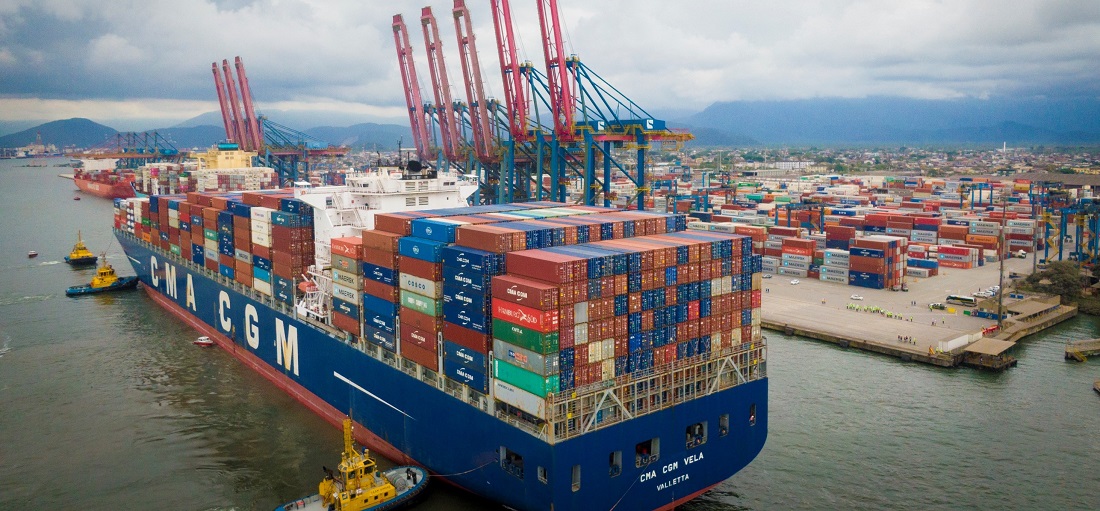
Upon receiving 347-meter vessels, Santos integrates into ‘giant’ freighters route
Dec, 06, 2022 Posted by Gabriel MalheirosWeek 202249
The Port of Santos has received ‘giant’ freighters. Aside from the large ships, nearly 350 meters in length, that have recently docked at the Sao Paulo port, vessels with high transport capacity have also integrated the maritime complex into their route. This is the case of a freighter capable of transporting nearly 14,000 TEU.
In October, Brasil Terminal Portuário (BTP), located in the Alemoa region, received the vessel Rio de Janeiro Express from the shipowner Hapag-Lloyd. It is a 335-meter-long vessel that stands out primarily for its capacity: 13,278 TEU, which is 3,000 TEU greater than the other 347-meter ‘giant’ freighters that passed through Santos recently.
“At BTP, these calls have been sporadic, but we expect a change in vessel profile, which is the case for the Hapag-Lloyd craft that joined the rotation for MSC and ONE’s Asia service – with stops that will be regular,” says Ricardo Trotti, Director of Operations at BTP.
The executive also points out that, in terms of length, the largest freighters that moored at the terminal were the 337-meter-long Seaspan Beacon, Seaspan Beauty, and Seaspan Bellwether from shipowner ONE. “The Rio de Janeiro Express, the largest ship ever received by BTP, will return to the terminal later this week.”
Santos Port Authority (SPA), the state-owned company that manages the Port of Santos, offered a comment saying that “shipping companies decide the size of the vessels that they deploy in their freight services.”
So far, the largest ships that have sailed in the Port of Santos are 347 meters long. However, the Pilotage of São Paulo and the University of São Paulo (USP) proved the viability of operating ships up to 366 meters in Santos.
However, a change in the operational draft is needed. According to the SPA, the current draft (vertical distance between the bottom of the keel and the ship’s waterline) limits vessels from transiting between the Barra entrance and BTP’s terminal, a stretch whose draft varies from 13.5 meters to 14.5 meters during high tide. From Alemoa to the end of the port, the draft goes from 12.7 to 13.7 meters.
According to simulations conducted in 2016, the approval for larger vessels with dimensions like 340 meters and 366 meters to cross the port is contingent on having an available draft of up to 14.2 meters. Thus, the port’s administration goal now is to achieve an operational draft of 14.5 meters at high tide, which is currently the maximum allowed in the channel for ships up to 340 meters. “On the topic of the increase in the authorized draft for ships over 340 meters in length, the simulation reports are still in production,” says the SPA.
On a note, DP World Santos, a terminal located on the port’s Left Bank, welcomes the arrival of these ‘giant’ freighters to secure Santos’ role as the largest port in Latin America and as a cargo hub. “The terminal today has an operational draft of 16 meters deep and, therefore, has full capacity to receive this new fleet of 366-meter ships.”
See below the track record of container exports from the Port of Santos compared to imports in the period between Jan 2019 and Oct 2022, according to the DataLiner market intelligence service.
Exports and imports – Port of Santos | Jan 2019 – Oct 2022 | TEU
Source: DataLiner (click here to request a demo)
Works needed
The need for infrastructure works in the Port of Santos’ navigation channel is becoming more apparent as demand grows and large ships arrive more frequently.
These investments are critical for the Santos pier terminals in order for the complex to receive such vessels.
According to Ricardo Trotti, Director of Operations at Brasil Terminal Portuário (BTP), water depth and infrastructure are what Santos needs to establish itself on the route of large container ships. “It is critical to increasing the operational draft while maintaining depths to allow for periodic calls for large ships. And establishing the private management of the Port of Santos’ navigation channel is required for better planning, speed of dredging, and better conditions for maneuvering these giant ships.”
Trotti also emphasized that, in addition to the public interest, private investments will also be needed. “It is also important to consider the need to invest in expanding the installed capacity of the terminals to guarantee that shipowners will allocate the modern giant vessels to the services that call at the Port of Santos. The expectation is that, very soon, in case there is no increase in operation capacity, we will have serious problems meeting market demand.”
DP World Santos reiterates that dredging the access channel is fundamental to allow a greater draft and better use of the capacity of these vessels.
Source: A Tribuna
To read the full original article, please go to: https://www.atribuna.com.br/noticias/portomar/apos-receber-navios-de-347-metros-santos-se-consolida-como-rota-de-cargueiros-gigantes
-
Ports and Terminals
Mar, 29, 2020
0
Ponta do Felix Port Terminals presents its plan to help during pandemic
-
May, 26, 2022
0
Brazil’s 2022/23 orange crop is expected to grow 20.5% in important areas
-
Ports and Terminals
Mar, 15, 2024
0
Maranhão state and Petrobras convene to assess Port of Itaqui potential for oil operations
-
Meat
Apr, 27, 2022
0
Brazilian fish farming exports grew 119% in value in Q1 2022

